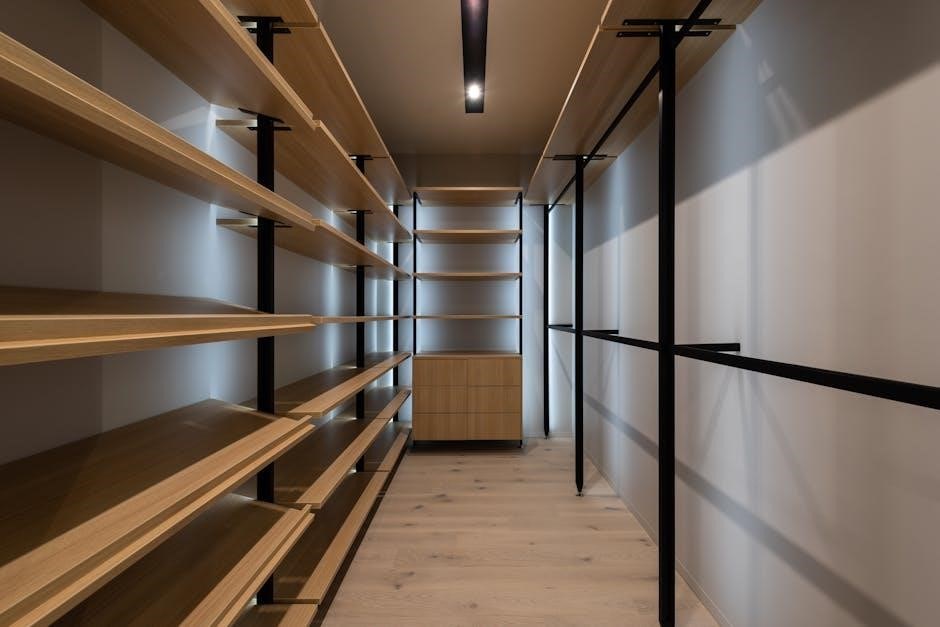Ensure a smooth transition into your new home with a comprehensive walk-through checklist. This essential guide helps verify all systems and features are in perfect condition, providing peace of mind for homeowners.
What is a New House Walk Through Checklist?
A new house walk-through checklist is a detailed guide used to inspect and verify the condition of a property before finalizing its purchase or lease. It helps ensure that all systems, features, and components of the home are functioning properly and meet agreed-upon standards. The checklist typically covers both exterior and interior aspects, including the foundation, walls, roof, plumbing, electrical systems, and appliances. It also allows buyers to document any issues or needed repairs, ensuring transparency and accountability. By following the checklist, homeowners can confidently assess their new property and address any concerns before closing the deal.
Why is a Walk Through Checklist Important?
A walk-through checklist is crucial for ensuring a smooth transition into a new home. It allows buyers to systematically inspect every aspect of the property, from the foundation to the roof, and identify potential issues. This process helps prevent costly surprises post-purchase by documenting defects or needed repairs. It also ensures that all agreed-upon modifications or fixes have been completed. By using a checklist, homeowners can verify that systems like plumbing, electrical, and HVAC are functional. This step provides peace of mind and protects the buyer’s investment, making it an indispensable tool in the home-buying process. Its importance lies in its ability to safeguard against oversight and ensure everything is in order before closing.

Preparation for the Walk Through
Prepare for a successful walk-through by gathering essential tools and materials, such as a PDF checklist, pen, camera, and charger for testing outlets, ensuring efficiency and thoroughness during the inspection.
Items to Bring to the Walk Through
To ensure a thorough inspection, bring essential items like a PDF checklist, pen, and camera to document findings. A phone charger is useful for testing outlet functionality. Allocate at least one hour for the walkthrough. Optional tools include a level for checking surfaces and a flashlight for inspecting dark areas. Organize these items beforehand to avoid delays. A notebook can help jot down notes or questions. Having all materials ready ensures efficiency and completeness during the process. Proper preparation allows you to focus on evaluating the property’s condition and addressing any concerns before finalizing the purchase. This step is critical for a smooth transition into your new home.
Downloading and Organizing the Checklist PDF
Begin by downloading a new house walk-through checklist PDF to ensure you don’t miss any critical details. Organize the document digitally or print it for easy reference. Use a digital tool to annotate and mark off items as you inspect them. If printed, bind the pages securely to avoid losing any sections. Review the checklist beforehand to familiarize yourself with the categories and ensure it covers all areas of the property. Having a well-organized checklist saves time and helps you stay focused during the inspection. This preparation ensures you can thoroughly evaluate the home’s condition and address any issues before finalizing the purchase. A structured approach guarantees nothing is overlooked.
Time Allocation for the Inspection
Allocate sufficient time to conduct a thorough walk-through inspection. A minimum of 1 hour is recommended, but this may vary depending on the property size and complexity. Start with the exterior, ensuring you inspect the foundation, walls, roof, and landscaping. Next, move indoors, systematically evaluating each room, including walls, floors, doors, and windows. Allow additional time for testing electrical systems, plumbing fixtures, and appliances. Finally, review your findings and document any issues. Proper time allocation ensures a detailed assessment, helping you identify potential problems before finalizing the purchase. A rushed inspection may overlook critical defects, so plan accordingly to cover all aspects thoroughly.

Exterior Inspection Checklist
foundation and structure for any cracks or damage. Check the walls and siding for signs of wear or defects. Inspect the roof for missing shingles or leaks and ensure the gutters are functioning properly. Finally, assess the landscaping and irrigation systems to confirm everything is in working order. This step ensures the home’s exterior is in good condition, preventing future issues.
foundation and structure. Check for any visible cracks or damage in the foundation walls, floors, and piers. Ensure the foundation is level and stable. Look for signs of water damage or moisture accumulation, which could indicate drainage issues. Inspect the structural integrity of beams, joists, and columns. Verify that all windows and doors are properly aligned, as misalignment could signal structural problems. Document any concerns or defects for further evaluation or repairs. This step is crucial to ensure the home’s structural soundness and prevent costly future issues. Proper documentation ensures transparency and accountability. Inspect the exterior walls and siding for any cracks, dents, or damage. Check for signs of water damage, warping, or rotting wood; Ensure the siding is properly installed and aligned. Look for gaps or loose panels that could allow moisture intrusion. Verify that all surfaces are evenly finished and free from fading or discoloration. Pay attention to areas around windows, doors, and corners, as these are prone to damage. Check for any missing or damaged trim and molding. Ensure all exterior surfaces are securely fastened and sealed. Document any issues for repair or further inspection. Properly maintained exterior walls and siding protect the home from weather and pests, ensuring long-term durability and curb appeal. Examine the roof for missing, damaged, or curled shingles. Check for cracks in shingles and ensure proper sealing around vents and flashing. Inspect gutters and downspouts for blockages, sagging, or rust. Verify that gutters are securely attached to the house. Look for signs of water pooling or overflow, which can indicate poor drainage. Ensure the roof is free from debris and that all edges are properly sealed. Check for any signs of wear around chimneys, skylights, or other roof features. Properly functioning gutters and a well-maintained roof are crucial for preventing water damage and structural issues. Document any damage or needed repairs to ensure the system functions correctly during rain and snow. A thorough inspection ensures your home remains protected from the elements. Inspect the landscaping for even grass coverage, healthy plants, and proper edging. Check for any signs of pests, weeds, or uneven terrain. Verify that all outdoor features, such as patios and walkways, are in good condition. Examine the irrigation system, ensuring sprinklers are functional and properly aligned. Test the irrigation controller to confirm it operates correctly and adheres to scheduled watering times. Look for leaks or damaged sprinkler heads that could waste water or cause damage. Ensure the system covers all necessary areas without over-saturating specific spots. Document any issues, such as non-operational sprinklers or uneven watering patterns, to address before finalizing the purchase. A well-maintained landscaping and irrigation system enhances curb appeal and ensures efficient water use. Proper functionality is essential for preserving the property’s exterior and preventing costly future repairs. A thorough interior inspection ensures all rooms, walls, ceilings, and flooring are in excellent condition. Check for any cracks, water damage, or uneven surfaces. Verify that all doors and windows open and close smoothly, ensuring proper alignment and functionality. Test smoke detectors to confirm they are operational. Inspect lighting fixtures and switches to ensure they are working correctly. Document any issues found during the inspection to address them before finalizing the purchase. This checklist helps identify potential problems early, ensuring a smooth transition into your new home. Proper functionality and aesthetics are vital for a comfortable living space.
A room-by-room evaluation is crucial during the final walk-through of your new home. Start by inspecting each room individually, beginning with the living areas, bedrooms, and bathrooms. Check for any signs of damage, such as cracks in the walls or water stains on the ceilings. Ensure that all lighting fixtures, switches, and outlets are functioning properly. Test windows and doors to make sure they open and close smoothly. In the kitchen, verify that all appliances are operational and that countertops and cabinets are in good condition. Pay attention to details like flooring quality and proper ventilation in each space. Documenting these observations helps in identifying any issues that may need attention before you move in. This thorough process ensures that every part of your new home meets your expectations, providing peace of mind for a smooth transition. Proper evaluation of each room ensures functionality and aesthetics are up to standard. Inspecting the condition of walls, ceilings, and flooring is a critical part of the new home walk-through. Check walls for cracks, uneven surfaces, or paint imperfections. Look for water stains, sagging areas, or discolored patches on ceilings that might indicate leaks. Floors should be level, with no unevenness or damage. Verify that all flooring materials, such as hardwood, tile, or carpet, are installed correctly and free of defects. Ensure there are no gaps between flooring and walls. Take note of any issues and document them for further action. This step ensures your new home’s structure and aesthetics meet quality standards, preventing future surprises. Proper assessment guarantees durability and longevity of these essential features. Ensure all doors and windows are functioning correctly during your new home walk-through. Check that doors open and close smoothly, with proper alignment and no signs of damage. Verify that locks operate securely and keys fit correctly. For windows, test each pane to ensure they open, close, and lock without issues. Look for any cracks or broken seals in glass panes. Check for proper sealing to prevent air leaks and ensure energy efficiency. Document any sticking, misalignment, or functional issues. Functional doors and windows not only enhance security but also contribute to comfort and energy savings. Addressing these issues early ensures your home is secure, energy-efficient, and ready for occupancy. Proper functionality is essential for both safety and convenience. Ensure smoke detectors are installed on every level of the home and in each bedroom. Test each detector to confirm they are functioning properly. Check for any signs of damage or tampering. Verify that all detectors are interconnected so they sound simultaneously. Replace batteries if necessary, and note the expiration dates of any hardwired units. Ensure carbon monoxide detectors are also present and functional. Document any issues or missing devices. Properly functioning smoke detectors are critical for safety and must be addressed before finalizing the walk-through. Ensure all fire safety measures meet local building codes and standards. Addressing these ensures a safe living environment for occupants. Testing and verification are essential steps in the process. Inspect all light switches, outlets, and circuit breakers to ensure proper functionality. Verify wiring integrity and check for any flickering lights or warm outlets. Test GFCI outlets. Ensure all electrical components are safe and operational. Begin by flipping every light switch to ensure lights turn on and off smoothly. Plug a device into each outlet to confirm power. Check GFCI outlets near water sources for proper function. Test dimmer switches for correct dimming operation. Look for any flickering lights, which may indicate loose connections. Use an outlet tester to verify proper wiring and grounding. Note any outlets that do not work or feel warm to the touch. Ensure all switches and outlets are securely mounted and show no signs of damage or wear. This step ensures the electrical system is safe and fully functional. Start by locating the main electrical panel and ensuring it is easily accessible. Check for any tripped breakers and reset them if necessary. Verify that all breakers are labeled correctly. Look for signs of wear, overheating, or rust on the panel and breakers. Ensure the main breaker functions properly by turning it off and on. Test individual breakers to confirm they control the correct circuits. Check for any flickering lights or outlets that stop working when a breaker is tripped. Document any issues, such as loose connections or unusual odors. This step ensures the electrical system is safe and functioning as intended. Ensure all wiring is properly installed and meets safety standards. Look for frayed cords, loose connections, or exposed wires. Test outlets with a multimeter to confirm they are grounded and functioning correctly. Check for the presence of GFCI outlets in areas like kitchens and bathrooms. Verify that all switches control the correct lights or fixtures. Inspect the electrical panel for proper wire connections and ensure no wires are overloaded. Check for consistent wiring colors to avoid confusion. Ensure all junction boxes are securely closed and tamper-proof. Document any issues, such as flickering lights or warm outlets, for further inspection. Proper wiring ensures safety and reliability in your new home. Inspect fixtures, test water pressure, and check for leaks. Ensure proper drainage and function of the water heater. Verify all systems are operational and secure. Examine all plumbing fixtures and faucets for proper function and appearance. Check for leaks under sinks, around toilets, and near showerheads. Ensure water flow is consistent and temperature controls work. Look for any signs of water damage or mineral buildup. Test each faucet’s hot and cold settings. Inspect toilets for proper flushing and seating. Verify that all bathroom and kitchen fixtures are securely mounted and free of cracks. Make note of any dripping or running water, as these could indicate issues needing repair. Ensure all included fixtures are present and in good condition before finalizing the walkthrough. Test water pressure by turning on all faucets to ensure even flow and check for any noticeable drops in pressure. Inspect under sinks, around dishwashers, and near water heaters for signs of leaks or water damage. Run each faucet for at least 30 seconds to identify drips or slow draining issues. Check the showerhead for proper water flow and pressure. Verify that the water heater is functioning correctly and set to the appropriate temperature. Ensure all drains are clear and water flows smoothly without backups. Document any leaks or low-pressure areas for further inspection or repair before finalizing the walkthrough process. Check the drainage system by running water through all sinks, toilets, and showers to ensure proper flow and absence of backups. Inspect pipes under sinks and around appliances for leaks or water damage; Verify that waste lines are clear and functioning correctly. For the water heater, ensure it is set to the correct temperature and check for any signs of leaks or rust. Test the temperature and pressure relief valve to confirm it operates smoothly. Make sure the water heater is properly secured and installed. Document any issues for repair before finalizing the walkthrough, ensuring all systems are in optimal condition for safe and efficient use. Inspect all appliances and fixtures to ensure they are in working condition. Verify that all included items are present and functioning as specified in the agreement, ensuring reliability and readiness for immediate use. During the walkthrough, it is essential to thoroughly test all kitchen appliances to ensure they are operational. Start by turning on the oven and stove to check for proper heating and functionality. Verify that the refrigerator maintains consistent temperatures and that the freezer operates correctly. Additionally, inspect the dishwasher for any signs of leaks or malfunction during a test cycle. Finally, check that the microwave and any other built-in appliances are functioning as intended. This step ensures that all kitchen features are ready for immediate use, avoiding potential issues post-closing. Properly documenting any malfunctions is crucial for timely repairs or replacements. During the walkthrough, inspect all lighting fixtures to ensure they are installed correctly and functioning properly. Turn on every light switch to confirm the corresponding fixture operates without flickering or dimming. Check for any visible damage, such as cracked lenses or loose connections. Verify that all fixtures are included as per the agreement, including any ceiling fans or under-cabinet lighting. Additionally, ensure that exterior lighting, such as porch or garage lights, is operational. Document any issues, such as non-working bulbs or faulty switches, and confirm replacements or repairs are addressed before closing. This step ensures all lighting systems are ready for immediate use and meet your expectations. Proper documentation is key for resolving any discrepancies efficiently. Verify that all items agreed upon in the purchase agreement are present and accounted for. This includes appliances, fixtures, furniture, or any other personal property specified in the contract. Check for missing items, such as garage door openers, keys, or manuals for systems and appliances. Ensure that no unwanted items, like leftover materials or debris, remain on the property. Document any discrepancies and bring them to the seller’s attention. This step ensures that the home is handed over in the condition agreed upon, with all included items intact and ready for your use. Proper documentation helps resolve any issues promptly and efficiently. The final walk-through ensures your new home is in the agreed condition. Use your checklist to verify repairs, check functionality, and confirm all items are present and working properly. Begin by reviewing your new house walk-through checklist to ensure all areas are covered. Start with the exterior, checking the foundation, walls, and roof for any damage or issues. Move inside, inspecting each room systematically, focusing on walls, ceilings, and flooring. Test all doors and windows for proper functionality. Verify that smoke detectors and fire safety systems are operational. Examine electrical systems by testing light switches and outlets. Check plumbing fixtures for leaks and ensure proper water pressure. Inspect kitchen appliances and lighting fixtures to confirm they are in working order. Document any issues found and ensure all repairs are completed before finalizing the process. During the final inspection, carefully identify any defects or needed repairs. Use your new house walk-through checklist to systematically note issues such as cracks in walls, uneven floors, or malfunctioning fixtures. Document each problem with photos and detailed descriptions, including locations and severity. This ensures clarity for contractors or the seller. Organize findings in your checklist PDF for easy reference. Prioritize issues based on urgency and impact on livability. This process helps prevent oversight and ensures all concerns are addressed before closing. Clear documentation also provides a record for future repairs or warranties, safeguarding your investment in your new home. After identifying issues, verify that all agreed-upon repairs and modifications have been completed. Refer to your new house walk-through checklist to ensure each problem has been addressed. Check that repairs meet quality standards and align with the initial agreement. Test any systems or fixtures that were previously faulty to confirm proper functionality. If modifications were made, ensure they match the agreed-upon specifications. Document the completion of repairs in your checklist PDF for clarity. If any issues remain unresolved, discuss them with the seller or contractor before finalizing the process. This step ensures your new home is move-in ready and meets your expectations, providing peace of mind and accountability. Accurately document findings using the PDF checklist, noting all observed issues and repairs. Clear reporting ensures transparency and accountability, aiding in resolving any discrepancies efficiently. Documenting findings during a new house walk-through requires thoroughness. Use the PDF checklist to note every issue, no matter how minor. Clearly describe each problem, including its location and severity. Take photos or videos as visual evidence to support your observations. Organize findings systematically, ensuring each item is easy to reference. Prioritize issues that need immediate attention and those that can be addressed later. Finally, review your documentation for accuracy and completeness before sharing it with relevant parties, such as the seller or contractor. This ensures transparency and helps resolve issues efficiently, providing a clear record for future reference. Utilize the PDF checklist to streamline reporting during your new house walk-through. The checklist provides a structured format to document each inspection point, making it easy to track progress. Each section, from exterior to interior and systems, is clearly outlined, allowing for efficient data entry. Upon completion, the checklist serves as a comprehensive report, highlighting all observed issues. Share the PDF with contractors or sellers to ensure clarity and accountability. This method reduces misunderstandings and ensures all parties are aligned on necessary repairs or modifications, fostering a smooth resolution process. The PDF format is also easily accessible and shareable, making it a practical tool for effective communication. After completing the walk-through, review the checklist to identify any issues or needed repairs. Document all findings and discuss them with the seller or contractor to ensure clarity. Schedule any necessary repairs or modifications based on the agreed-upon timeline. Obtain written confirmations for all agreed-upon actions. Review warranties and manuals for appliances and systems to understand maintenance requirements. Finalize the closing process, ensuring all documentation is complete. Once all issues are resolved, receive the keys and officially take possession of your new home. This structured approach ensures a smooth transition and provides peace of mind for the homeowner. The closing process involves finalizing all paperwork and ensuring the property is officially transferred. Verify all repairs are completed, and receive the keys and ownership documents. The closing process is the final step in acquiring your new home, involving legal and financial transactions. It ensures the property is legally transferred, and all obligations are met. Key aspects include signing the deed, transferring ownership, and completing any outstanding payments. This process is typically facilitated by a legal representative or title company. Proper documentation is essential to ensure a smooth handover. Once completed, you receive the keys and official ownership of the property, marking the end of the walkthrough and inspection phase. This step is crucial for a stress-free transition into your new home. Finalizing the walk-through involves reviewing and confirming all items on the checklist. Ensure no issues are overlooked by cross-verifying each component, from exterior to interior systems. This step is crucial for accountability and satisfaction. Once completed, all parties acknowledge the property’s condition, and any agreed repairs are noted. Finalizing ensures clarity and prevents future disputes, providing a clear record of the property’s state at handover. Proper documentation is key, with signatures from all parties involved. This step concludes the inspection process, allowing the closing to proceed smoothly. Receiving keys and documentation marks the official transfer of ownership. Ensure all sets of keys, including spare sets, are handed over. Verify that all necessary documents, such as property deeds, warranties, and manuals for appliances, are provided. Review these documents to understand your responsibilities and rights as the new homeowner. This step ensures you have everything needed to maintain and enjoy your property. Proper documentation also serves as a reference for future repairs or upgrades, providing clarity and peace of mind. Organize these materials securely for easy access when needed.Foundation and Structure Evaluation
Exterior Walls and Siding Condition
Roof Inspection and Gutter System
Landscaping and Irrigation Systems

Interior Inspection Checklist
Room-by-Room Evaluation
Walls, Ceilings, and Flooring Condition
Doors and Windows Functionality
Smoke Detectors and Fire Safety

Electrical System Checklist
Testing Light Switches and Outlets
Inspecting Circuit Breakers and Panels
Checking for Proper Wiring

Plumbing System Checklist
Fixtures and Faucets Inspection
Water Pressure and Leaks
Drainage and Water Heater

Appliances and Fixtures Checklist
Testing Kitchen Appliances
Verifying Lighting Fixtures
Ensuring All Included Items Are Present

Final Walk Through Process
Step-by-Step Guide to the Final Inspection
Identifying and Documenting Issues
Verifying Repairs and Modifications

Documentation and Reporting
How to Document Findings
Using the PDF Checklist for Reporting
Next Steps After the Walk Through

Closing Process and Handover
Understanding the Closing Process
Finalizing the Walk Through
Receiving Keys and Documentation

Leave a Reply
You must be logged in to post a comment.